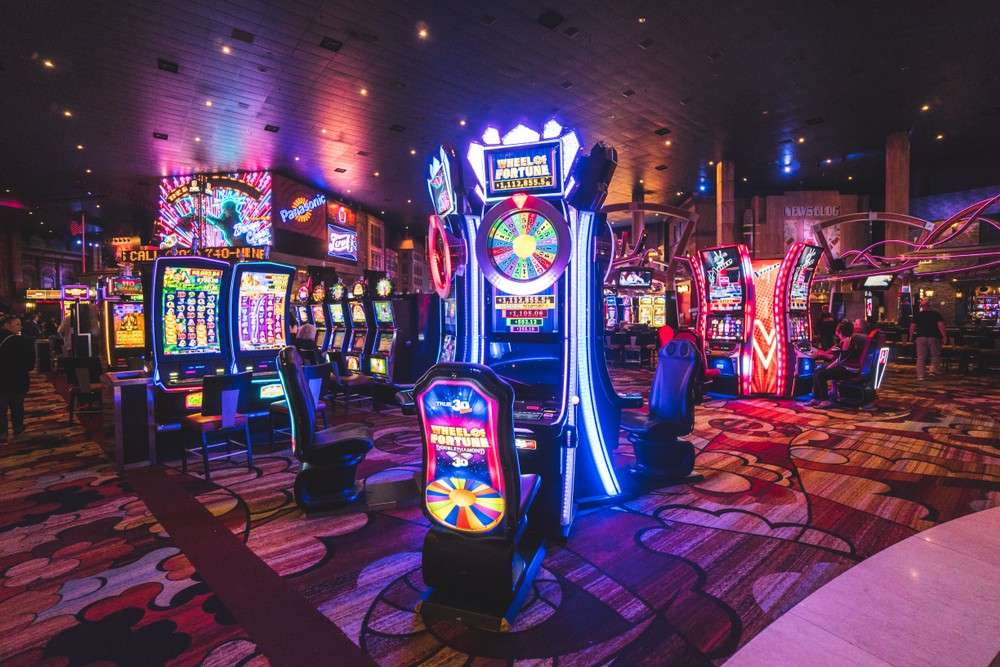Slot machines, the iconic attractions of any casino floor, have evolved far beyond the simple mechanical devices of the past. Today’s slot machines are sophisticated marvels designed to captivate players and keep them spinning the reels. Behind the flashing lights and alluring sounds lies a carefully crafted science known as “slot psychology.” In this article, we delve into the fascinating world of slot psychology, exploring how these machines are expertly engineered to play with our minds and keep us coming back for more.

The Illusion of Control
The illusion of control is a powerful psychological element that plays a significant role in the design and allure of modern slot machines. When players interact with the buttons or levers on the slot machine, they are led to believe that they can influence the outcome of the game. This sense of agency creates a feeling of empowerment and engagement, as players believe that their actions can sway the results in their favor. As a result, players become more immersed in the gambling experience, feeling in control of their destiny with each spin.
In reality, modern slot machines operate using random number generators (RNGs), sophisticated algorithms that generate a sequence of numbers at a rapid pace. These numbers correspond to the symbols on the slot reels, determining the outcome of each spin. The RNG ensures that each spin is entirely independent of previous spins and that the results are genuinely random. Regardless of the timing of the button press or lever pull, the outcome is already determined by the RNG before the player even initiates the spin.
Despite the fixed odds and random nature of the slot machine outcomes, the illusion of control persists, and players continue to believe that their actions can influence the game’s results. This cognitive bias is known as the “illusion of control” and is a fundamental aspect of human behavior in decision-making scenarios. In the context of slot psychology, the illusion of control keeps players engaged and invested in the game, leading them to continue playing in the hope of achieving a favorable outcome.
The illusion of control is further enhanced by the presence of certain features in slot machines. For example, some machines display symbols just above or below the payline, creating a near-miss effect. These near-miss moments give players the false impression that they were very close to winning, reinforcing their belief that their actions almost led to a favorable outcome. As a result, players become more determined to continue playing, thinking that their next attempt might be the lucky one.
Casino operators and game developers capitalize on the illusion of control by designing slot machines to provide auditory and visual feedback for each spin. The spinning reels, celebratory sounds for wins (no matter how small), and flashing lights create a stimulating and exciting atmosphere. This sensory experience triggers the release of dopamine in the brain, which is associated with pleasure and reward. As a result, players experience a positive emotional response even during periods of losses, making them more likely to persevere and continue playing.
The illusion of control is a potent psychological element that influences players’ perceptions and behaviors when playing modern slot machines. Despite the fact that slot outcomes are determined by random number generators and are entirely independent of player actions, the illusion of control leads players to believe that they can influence the game’s results. This belief keeps players engaged, immersed, and motivated to continue playing, contributing to the enduring popularity of slot machines in casinos worldwide.
Reward and Reinforcement
Slot psychology utilizes operant conditioning principles to create an engaging and addictive experience for players. Operant conditioning is a psychological concept that involves reinforcing behaviors through rewards and punishments. In the context of slot machines, this means that players are rewarded with payouts when they play the game, reinforcing the behavior of continuing to play.
One of the key strategies employed in slot design is the use of an intermittent reinforcement schedule. Unlike continuous reinforcement, where players receive a reward every time they play, intermittent reinforcement offers rewards unpredictably and at irregular intervals. This type of reinforcement schedule is highly effective in maintaining player interest and motivation.
The intermittent reinforcement schedule in slot machines creates an element of uncertainty and excitement for players. When players spin the reels, they do not know when or if they will receive a payout. This unpredictability leads to a heightened sense of anticipation and arousal during each spin, making the gambling experience more thrilling and engaging.
The allure of intermittent reinforcement lies in the occasional occurrence of significant rewards, commonly known as “big wins.” Even though these big wins may be infrequent, they have a powerful impact on players. The possibility of hitting a substantial jackpot keeps players hooked, as they believe that the next spin could be the one that changes their fortunes.
Psychologically, intermittent reinforcement leads to the development of a behavior known as “persistent gambling.” When players are occasionally rewarded with wins, they are more likely to continue playing, hoping to experience that euphoric feeling again. The intermittent rewards effectively reinforce the behavior of playing the slot machine, encouraging players to spend more time and money on the game.
The use of intermittent reinforcement in slot machines also has parallels with other forms of gambling, such as lottery tickets and scratch cards. The occasional small wins and the possibility of a life-changing jackpot draw players in and keep them coming back for more.
In addition to intermittent reinforcement, slot machines often use other psychological tactics to enhance player engagement. For example, the presence of visual and auditory cues during wins, even if they are small, creates a sense of achievement and pleasure. These cues trigger the release of dopamine in the brain, which is associated with feelings of pleasure and reward, further reinforcing the gambling behavior.
Slot psychology leverages operant conditioning principles, particularly the intermittent reinforcement schedule, to maintain player engagement and foster persistent gambling behavior. The uncertainty and occasional big wins create a sense of excitement and anticipation, keeping players hooked on the game. Understanding the psychological mechanisms at play in slot design is essential for responsible gambling and for making informed choices while enjoying the casino experience.

Slot Machines: Lights, Sounds, and Colors
The captivating sensory experience of slot machines is a deliberate design strategy employed by casinos to enhance slot psychology and player engagement. When players sit in front of a slot machine, they are greeted with a mesmerizing symphony of lights, colors, and sounds that create an immersive atmosphere. The purpose of this sensory spectacle is to evoke feelings of excitement and celebration, regardless of whether the player wins or loses. This sensory stimulation is carefully crafted to make players associate playing slots with pleasure and reward.
Vibrant colors are a prominent feature of slot machine design. Casinos use a range of eye-catching colors, often in neon or bright tones, to create a visually stimulating environment. These colors are known to trigger emotional responses in the brain, such as excitement and arousal. The visual appeal of the slot machines draws players in and captures their attention, setting the stage for an engaging gambling experience.
In addition to colors, flashing lights are a prevalent feature in slot machines. When a player wins, the machine emits a flurry of flashing lights, creating a sense of celebration and triumph. Even during regular spins without a win, the lights continue to flicker, maintaining a level of excitement and anticipation for the next spin. These light displays are designed to intensify the emotional experience of playing, making players feel like they are part of a thrilling event.
Furthermore, cheerful melodies and sound effects play a crucial role in slot psychology. The sound of spinning reels, the jingling of coins, and the cheers and applause during a win all contribute to the sensory experience of playing slots. These auditory cues trigger the release of dopamine, a neurotransmitter associated with pleasure and reward, in the brain. The brain begins to associate the sound of the slot machine with positive feelings, further reinforcing the desire to continue playing.
The combination of vibrant colors, flashing lights, and cheerful melodies creates a multisensory experience that entices players to stay engaged with the slot machine. Even if players experience losses, the positive sensory stimulation can still lead to a sense of enjoyment and anticipation for the next spin. This is a crucial aspect of slot psychology, as it encourages players to keep playing and contributes to the overall allure of slot machines.
It’s essential to recognize that while these sensory elements enhance the gambling experience, they are also designed to keep players playing for more extended periods. Casinos carefully study the impact of these sensory stimuli on player behavior and adjust their designs accordingly to maximize player retention and engagement.
The mesmerizing symphony of lights and sounds emitted by slot machines is a deliberate strategy employed by casinos to enhance slot psychology. The use of vibrant colors, flashing lights, and cheerful melodies triggers a release of dopamine in the brain, reinforcing the association between playing slots and feelings of pleasure and reward. This multisensory experience captivates players and contributes to the allure of slot machines, enticing them to continue playing and fostering a sense of excitement and anticipation for the next spin.
Near-Miss Moments
Slot machines are designed with the intention of creating a thrilling and engaging gambling experience for players. One of the most potent techniques used to achieve this is the incorporation of near-miss moments. A near-miss occurs when the symbols on the slot reels come tantalizingly close to forming a winning combination, but ultimately fall just short. These near-miss moments trigger a sense of excitement and anticipation in players, as they feel they were incredibly close to hitting the jackpot. This feeling of being “almost there” compels players to try again, believing that the next spin might be the lucky one.
Research in the field of psychology has provided valuable insights into the impact of near-misses on player behavior. Studies have shown that near-miss moments activate the brain’s reward pathways in a manner similar to actual wins. When players experience a near-miss, the brain releases dopamine, a neurotransmitter associated with pleasure and reward. This dopamine release reinforces the desire to continue playing, as players seek to recapture the excitement and satisfaction that comes with a winning outcome.
The allure of near-misses lies in their ability to create a sense of hope and optimism in players. Even though the outcome was not a win, the proximity to a winning combination makes players believe that they were close to success. This creates a cognitive bias known as the “illusion of control,” where players begin to believe that they can influence the game’s outcome through their actions. The illusion of control keeps players engaged, as they believe that their efforts could make a difference in achieving a win.
Casino operators and game developers strategically design slot machines to incorporate near-miss moments at specific intervals. These near-misses are not random but carefully calibrated to maximize their impact on player motivation. By presenting near-miss moments periodically, casinos create a sense of unpredictability and excitement, compelling players to continue playing in the hope of experiencing a satisfying win.
It is important to note that near-miss moments are not unique to physical slot machines but are also prevalent in digital slot games. In online slots, the visual representation of near-misses is equally compelling, with symbols aligning just short of a winning combination. The impact on player behavior is similar, as near-misses in digital slots also trigger the brain’s reward pathways and encourage continued play.
While near-misses can enhance player engagement and excitement, they have raised concerns among researchers and gambling experts. Some argue that the use of near-misses may contribute to problem gambling behavior, as players may become overly focused on trying to “chase” wins based on the belief that they were close to success. Understanding the psychological mechanisms at play in near-miss moments is essential for promoting responsible gambling practices and ensuring a safe and enjoyable gambling experience for all players.
Near-miss moments are a powerful tool used in slot machine design to keep players engaged and motivated. The tantalizingly close proximity to a winning combination triggers a sense of excitement and optimism, compelling players to continue playing in pursuit of a satisfying win. Research has shown that near-misses activate the brain’s reward pathways, reinforcing the desire to play and creating the illusion of control. While near-misses enhance the gambling experience, it is crucial to recognize their potential impact on player behavior and to promote responsible gambling practices within the casino industry.

Progression and Bonuses
Modern slot machines have evolved far beyond the simple one-armed bandits of the past. They now boast an array of enticing features designed to enhance the slot psychology and keep players engaged. One such feature is the inclusion of bonus rounds, which add an extra layer of excitement to the game. Bonus rounds are typically triggered by specific combinations of symbols or through a random event, offering players the opportunity to win additional rewards or free spins. The prospect of entering a bonus round creates anticipation and a sense of reward, motivating players to continue playing in hopes of experiencing these special moments.
In addition to bonus rounds, many modern slot machines feature multi-level games. These multi-level games introduce a sense of progression, as players advance through different stages of the game, each with its own set of challenges and rewards. As players move from one level to the next, they feel a sense of achievement and accomplishment, further reinforcing their desire to continue playing and reach the final level. The multi-level aspect creates a more immersive and interactive gaming experience, keeping players actively engaged with the slot machine.
One of the most significant draws of modern slot machines is the inclusion of progressive jackpots. These jackpots continue to grow as players wager on the game, with a portion of each bet contributing to the jackpot pool. The allure of potentially winning a life-changing sum of money keeps players coming back for more, even when the odds of hitting the jackpot are relatively low. The dream of winning a progressive jackpot adds an element of excitement and hope, making players willing to invest more time and money in pursuit of the grand prize.
The combination of bonus rounds, multi-level games, and progressive jackpots creates a compelling and enticing gambling experience. Players are continually driven by the desire to unlock bonus rounds, progress through the game’s levels, and ultimately, to hit the coveted progressive jackpot. Each feature contributes to the slot psychology, as players become immersed in the game, experiencing a range of emotions from anticipation to exhilaration.
Casino operators and game developers carefully design these features to optimize player engagement. By creating a sense of excitement and anticipation, they foster a feeling of enjoyment and satisfaction, even when players do not achieve significant wins. The gaming experience becomes more than just spinning reels; it becomes a journey of discovery and possibility, encouraging players to return to the slot machine for more adventures.
While these features add to the allure of modern slot machines, it is essential to approach gambling responsibly. The excitement and engagement provided by bonus rounds, multi-level games, and progressive jackpots should not overshadow the importance of setting limits and adhering to responsible gambling practices. Understanding the psychological appeal of these features can help players make informed decisions and enjoy the casino experience in a safe and enjoyable manner.
The incorporation of bonus rounds, multi-level games, and progressive jackpots in modern slot machines is a strategic approach to enhance slot psychology and keep players engaged. These features add layers of excitement, anticipation, and a sense of achievement, making the gambling experience more immersive and interactive. The allure of potentially life-changing jackpots further heightens the thrill, compelling players to invest more time and money in pursuit of their dreams. By understanding the impact of these features on player behavior, casinos can create a more enjoyable and responsible gambling environment for their patrons.
Bottom line
Slot psychology is an artful blend of science and design that makes slot machines irresistible to players. The illusion of control, the intermittent reinforcement, and the sensory experience all work together to create an immersive and captivating gambling experience. Understanding the mechanics of slot psychology can empower players to gamble responsibly and make informed choices. Next time you sit in front of a slot machine, remember that it’s not just chance at play – there’s a carefully crafted science enticing you to spin those reels one more time.